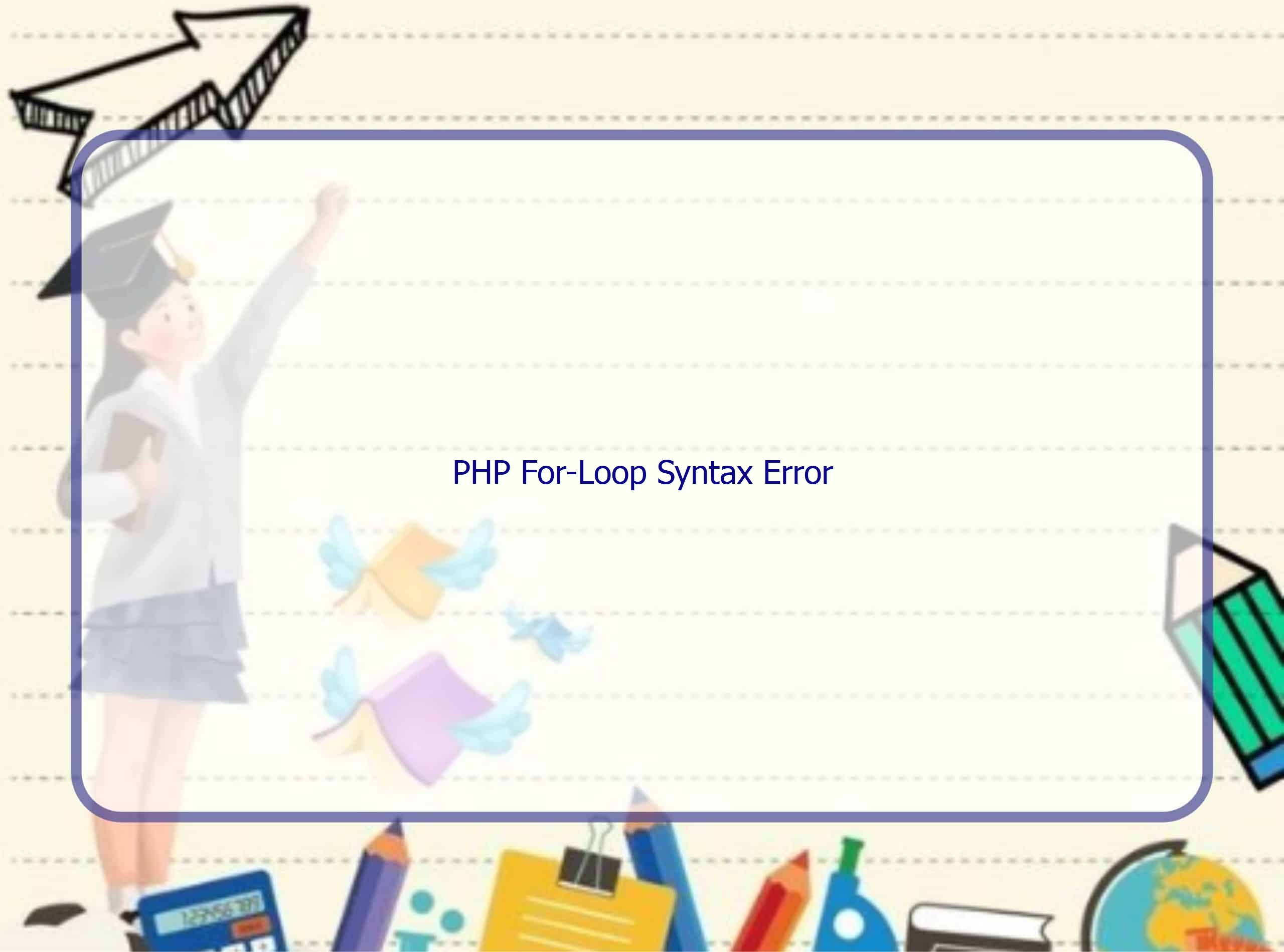Suggestions for fixing the syntax error
In order to fix the syntax error in the PHP for-loop, you need to make the following changes:
- Ensure that the concatenation operator “.” is correctly used in the code.
- Make sure that the variable $i is properly declared and used in the loop statement.
- Replace the invalid line of code with the corrected line of code.
Error in the usage of concatenation operator
The syntax error in the PHP for-loop is caused by the incorrect usage of the concatenation operator “.”. This operator is used to join strings together in PHP. However, in the code provided, it is being used incorrectly, resulting in the syntax error.
Here is the erroneous line of code:
$output .= $_POST["DepositCode"]$i . "," . $_POST["textfield"]$i . "," . $_POST["AccountNum"]$i . " \r\n";The syntax error occurs because the concatenation operator should be used to join the string values with the variable $i. To correctly concatenate the strings, you need to use the “.$i” syntax within the square brackets.
Explanation of the correct syntax
To fix the syntax error, you need to replace the erroneous line of code with the corrected version. Here is the correct syntax:
$output .= $_POST["DepositCode" . $i] . "," . $_POST["textfield" . $i] . "," . $_POST["AccountNum" . $i] . " \r\n";In the correct syntax, the concatenation operator “.” is used to join the string values with the variable $i. This ensures that the correct values are retrieved from the $_POST array and concatenated into the $output variable.
Related Questions
Reference Guide: What does this symbol mean in PHP? (PHP Syntax)
The symbol “?” in PHP is called the ternary operator. It is used for shorthand conditional statements. The ternary operator allows you to evaluate a condition and return one value if the condition is true, and another value if the condition is false.
How do I get PHP errors to display?
To display PHP errors, you can modify the php.ini file or use the ini_set() function in your PHP script. In the php.ini file, you can change the value of the error_reporting directive to display different levels of errors. Alternatively, you can use ini_set(‘display_errors’, 1) in your PHP script to enable error displaying for that particular script.
PHP parse/syntax errors; and how to solve them
PHP parse/syntax errors occur when the PHP interpreter encounters a mistake in the code that prevents it from being executed correctly. These errors can be caused by missing or misplaced brackets, semicolons, or other syntax elements. To solve parse/syntax errors, carefully review your code and check for any mistakes. Use proper indentation and follow best practices to avoid these errors.
Reference – What does this error mean in PHP?
When working with PHP, you might encounter various error messages. These error messages provide information about issues in your code or the server’s configuration. Understanding these error messages can help in troubleshooting and fixing the issue. It is important to refer to the PHP documentation or resources online to learn more about specific error messages and their meanings.
How does PHP ‘foreach’ actually work?
The PHP ‘foreach’ loop is used to iterate over arrays or objects. It allows you to loop through each element in the array or each property in the object. The ‘foreach’ loop automatically assigns the current element or property to a variable, which you can use within the loop block. This loop is particularly useful when working with arrays or objects where you do not know the exact number of elements or properties.
FAQ
How do I fix a syntax error in PHP?
To fix a syntax error in PHP, carefully review your code and check for any mistakes in the syntax. Look for missing or misplaced brackets, semicolons, or other syntax elements. Use proper indentation and coding practices to avoid syntax errors. If you are unsure about the cause of the error, consider using an IDE or a code editor with syntax highlighting and error checking features.
What is the purpose of the concatenation operator in PHP?
The concatenation operator “.” in PHP is used to join strings together. It allows you to combine multiple strings into a single string. This operator is particularly useful when you want to build dynamic strings by combining static text with variable values or other strings. It provides a convenient way to manipulate and construct strings in PHP.
How do I concatenate strings in PHP?
In PHP, you can concatenate strings using the “.” concatenation operator. To concatenate strings, simply use the operator between the strings that you want to join. Here is an example:
$string1 = "Hello";
$string2 = "World";
$result = $string1 . $string2;
echo $result; // Output: HelloWorldWhat is the purpose of the $_POST variable in PHP?
The $_POST variable in PHP is a superglobal variable that is used to collect data submitted through a POST request. When a form is submitted using the POST method, the values entered in the form fields are sent to the server and made available in the $_POST array. This allows you to retrieve the form data and process it in your PHP script.
How can I access form data submitted using the POST method in PHP?
To access form data submitted using the POST method in PHP, you can use the $_POST superglobal variable. The form field names are used as keys in the $_POST array, and the values entered in the form fields are the corresponding values in the array. Here is an example:
<form method="POST" action="process.php">
<input type="text" name="username">
<input type="password" name="password">
<input type="submit" value="Submit">
</form>
// process.php
$username = $_POST["username"];
$password = $_POST["password"];What is the purpose of the .= operator in PHP?
The “.=” operator in PHP is called the concatenating assignment operator. It is used to append a string to an existing string variable. This operator allows you to concatenate and update the value of a string variable in a single operation. Here is an example:
$string = "Hello";
$string .= " World";
echo $string; // Output: Hello WorldCan I use a variable inside square brackets in PHP?
Yes, you can use a variable inside square brackets in PHP. This is particularly useful when you want to dynamically access array elements or object properties. By concatenating a variable with a string within the square brackets, you can create a dynamic key or property name. Here is an example:
$array = [1, 2, 3];
$index = 1;
echo $array[$index]; // Output: 2What is the purpose of the “\r\n” in the corrected line of code?
The “\r\n” in the corrected line of code represents a carriage return and a line feed. It is used to create a new line in a text file or when outputting text. In this specific context, it is used to format the $output string so that each set of values is written on a new line. This can be helpful when you are saving the $output data to a file or displaying it in a certain way.
How can I improve my PHP coding skills?
Improving your PHP coding skills can be done through a combination of practice, reading documentation, and studying examples. Some tips to improve your PHP coding skills include:
- Consistently practice writing PHP code and working on small projects.
- Read the official PHP documentation to learn about the different features and functions in PHP.
- Study well-written PHP code examples and try to understand the logic and techniques used.
- Participate in online communities or forums where you can ask questions and learn from experienced PHP developers.
- Stay updated with the latest PHP developments and best practices through blogs, tutorials, and books.
Conclusion
In conclusion, the syntax error in the PHP for-loop can be fixed by correctly using the concatenation operator “.” and ensuring that the variable $i is properly declared and used. By following the suggestions provided and using the correct syntax, you can successfully fix the syntax error and execute the for-loop without any issues. Remember to review your code carefully and follow best practices to avoid syntax errors in the future.







